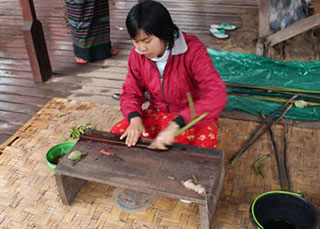The (NYMPHAECEAE) is a family of water plants which includes the water lilies. the sacred lotus (Nelumbo). and the spectacular Queen Victoria water lily (victoria amagorica). It is a family of 8 genera and about 90 species in fresh waters throughout most of the world. Where there are ponds. lakes and streams. water lilies will be found.
In Myanmar. which is a country dotted with ponds and lakes. large and small. there are many species of water lilies of all colours and sizes with their own Myanmar names. We have the Kya byu. European White Water Lily (Nymphaea alba) Kya Ni. Indian Water Lily (N. Nouchali Burmf) Kya Nyo. Kya Pya (N. Stellata Willd). the latter also known as the Indian Blue Water Lily. Kya-hkaung laung (Barclaya longi folia Walld) Kya-pu. the Pygmy Water Lily (N. tetra gona Georgi) Gamod Kya or Kumudra Kya. (Nymphaea Stellata Willd) and the Padon-ma Kya. the Sacred Lotus or Egyptian Lotus (Nelumbium speciosum Willd).


All these varieties can be found all over the country and the ‘Kya’ which is the name common to all is very much admired because we consider such beauty which emerges from the murky and muddy depths of still waters a marvel. The Padon-ma Kya is held especially sacred in Myanmar Culture and tradition. The Padon-ma Kya. the Sacred Lotus is believed to bloom only in sunlight and the Kumudra (Gamod) Kya. a fabulous white lily. is said to bloom only with moonlight. The Padon-ma Kya and the Gamod Kya are both very much appreciated by poets and writers but the Padon-ma Kya is especially considered sacred. When younger people pay obeisance to elders. the latter usually respond with blessings one of which goes: “May you be as fresh and dewy as a the Padon-Kya.”
The lotus motif is also found to be a decorative part in the architecture of Buddhist Shrines and sacred depositories such as Chedis. The upper part of a chedi just below the pinnacle consisting of the Diamond bud. the pennant-shaped vane and the umbrella (hti) is an elongated bulbous portion of the Chedi known as the banana bud. Just below it is the Kya-yint (Mum&ifh) that is a motif of large lotus petals encircling the chedi. Next is the Kya-lan (Mumvef). which is part of the Chedi that resembles a spreading upturned lotus flower. Then comes the Kya-nu which. is a motif of small lotus petals. and lastly the Kya-Hmauk (MumarSmuf) that resembles an inverted lotus flower. These motifs add to the grace and beauty of chedis. The lotus motif also decorates the pinnacles of tiered roofs of monasteries and palaces and there is also a vessel somewhat like a fruit stand decorated with lotus petals for offering food and fruits at sacred Buddha shrines. The exotic lotus. is a motif which also adorns the gold thrones on which we place Buddha images.


The Padon-ma Kya is a large bloom on a long thick thorny and fibrous stalk. The buds are like elongated bulbs that narrows at the tip. But when the petals open they are fabulous. The colour of the sacred lotus is a mix of whitish pink and red. And the white lotus. the Kumudra is pristine and pure.
The fibrous stalks yield strong threads. which are used for weaving the sacred ornamental robe to be offered at Buddha Images on the Full Moon Day of Tazaungmon (around November). a month after the end of the Festival of lights in October. The people of Inlay are most skilled in the spinning and weaving of the sacred lotus silk robe.
There are other mundane uses of the lotus plant. The seed of the lotus is edible. They are green and resemble a large peanut and come embedded in a cup-like bulb and is commonly called Kya-Khwet. (that is a lotus cup) on a stalk. It is a very tasty ingredient in steamed duck or as part of the stuffing in duck roast. They can also be eaten raw. Then the lotus leaf. before the era of things plastic. was used to wrap fresh fish and meat in bazaars.
One comes across large ponds and lakes full of water lily pads with flowers of all colours. throughout the whole country. even in the dry zone.
For me. it brings back memories of summer vacations in my father’s native town of Shwebo. which lies about 100 miles north of Sagaing. Shwebo is a hot. dry and dusty town. which can also be extremely cold between October and February. But. Shwebo was once Yadanatheinga. the capital of Alaungpaya’s Third Myanmar Empire. The town has thus a large moat and many lotus ponds with a variety of red. white. blue and purple water lilies. There was a large pond where in the Rice Mill Compound where we lived. It was a favourite spot for the children. consisting of cousins. sisters and me. And we used to paddle out in a dilapidated boat to the middle of the pond to gather “Kyar-Khwet” for the fresh and jade green seeds they held. The Padon-mar Kyar is considered sacred. but for me it is also associated with carefree summer vacations of childhood in my father’s native town of Shwebo.
Kyi Kyi Hla
